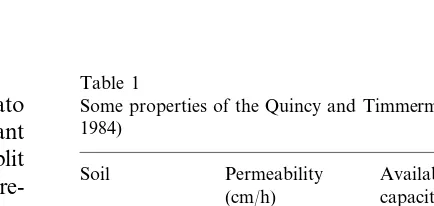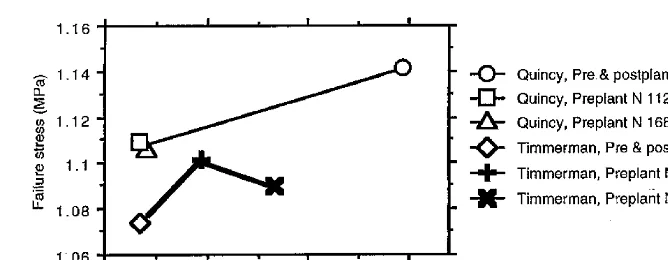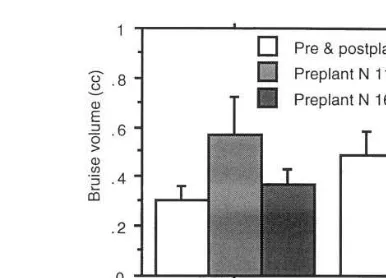Influence of early-season nitrogen application pattern on
impact sensitivity in Russet Burbank potato tubers
A.L. Baritelle
a, G.M. Hyde
a,*, R.E. Thornton
baBiological Systems Engineering Department,Washington State Uni
6ersity,Pullman,WA 99164-6120, USA bHorticulture and Landscape Architecture Department,Washington State Uni
6ersity,Pullman,WA 99164-6414, USA Received 25 November 1999; accepted 18 April 2000
Abstract
As part of an effort to assess the influence of cultural practices on bruising in potato tubers, this work was a preliminary study to determine whether the pattern of early-season nitrogen fertilizer application influences impact sensitivity (bruise threshold and bruise resistance) in Russet Burbank tubers. Tissue sample impact failure stress, strain, and shock wave speed, and whole-tuber bruise energy and bruise volume were measured on tubers from two soils and three early-season nitrogen fertilizer application patterns. Results showed that fertilizer pattern significantly influenced bruise threshold in the higher-permeability soil and bruise resistance in both soils. The worst fertilizer treatment resulted in bruises nearly twice the size of those in the other two treatments. The split 56 kg/ha preplant and 56 kg/ha postplant nitrogen treatment gave significantly higher bruise threshold in the higher permeability soil and highest bruise resistance in both soils (higher is better). Fertilizer treatment effects were less pronounced in the lower permeability soil, with no significant effect on bruise threshold in that soil. © 2000 Elsevier Science B.V. All rights reserved.
Keywords:Nitrogen fertilizer; Potato bruising; Impact sensitivity; Bruise threshold; Bruise resistance
www.elsevier.com/locate/postharvbio
1. Introduction
The $2.5 billion US potato (Solanum tubero
-sum) industry loses $300 million annually to
bruising, most of which could be saved through proper cultural practices, conditioning and han-dling (Brook, 1996). Most of that bruising is impact damage, primarily blackspot and shatter bruise (Thornton et al., 1974).
Potato impact sensitivity or ‘bruise susceptibil-ity’ varies from year to year and place to place, often widely and without explanation. We define impact sensitivity as having two components: bruise threshold and bruise resistance (Bajema and Hyde, 1998). Bruise threshold is the drop height at which bruising just begins to occur for a given tuber mass, radius of curvature at site of impact, and impact surface. Bruise resistance is the ratio of bruising energy to the resulting bruise volume, and can be thought of as the relative bruise size that will result from a given bruising
* Corresponding author. Tel.: +1-509-3351636; fax: + 1-509-3352722.
E-mail address:[email protected] (G.M. Hyde).
drop height for a given size tuber. Note that higher values for either bruise threshold or bruise resistance mean less impact sensitivity.
This research is part of an on-going effort to assess the influence of cultural practices on tuber bruising, and is a preliminary study to determine whether early-season nitrogen fertilizer applica-tion patterns influence tuber impact sensitivity. Nitrogen is an important nutrient in potato pro-duction. Gately (1971) stated that mean tuber yields were greatly increased by increased nitrogen fertilizer treatments. Westerman and Klienkopf (1985) also found that increasing nitrogen fertil-izer increased total tuber yields and reduced the yield of undersized tubers.
While the influence of potassium fertilizer on potato bruising is well documented (Ophius et al., 1958; Kunkel and Gardner, 1959; Hughes et al. 1975), literature on effects of nitrogen on bruising is sparse. Hughes (1980) reported that increased
nitrogen fertilizer significantly decreased
average tuber specific gravity each year of a three-year study. In the first three-year more nitrogen resulted in less bruising, but in the following two years nitrogen levels had little effect on bruising in that study (for further background see Baritelle, 1997).
The objective of this research was to determine whether early season nitrogen application patterns affected Russet Burbank potato tuber impact sen-sitivity in two soils under commercial growing conditions in the Columbia Basin of eastern Washington State.
2. Materials and methods
Commercially-grown Russet Burbank potato tubers from two soil types under three preplant
nitrogen fertilizer treatments (56 – 56 kg/ha split
preplant and 2 weeks post-plant, 112 kg/ha
pre-plant, and 158 kg/ha preplant) were tested using
two dynamic loading methods. The 112 kg/ha
treatment was the commercial recommendation used by the grower. Treatments were replicated
three times (18 experimental cells in a 2×3×3
factorial experimental design). All treatments
re-ceived an additional 207 kg/ha of in-season
nitro-gen through the sprinkler irrigation system. The soils were Quincy fine loamy sand and Timmer-man loamy sand. Both soils have 0.5 – 1% organic matter and about the same silt content. The cation exchange capacity (CEC) is higher for the Quincy soil. Other soil properties are listed in Table 1. Irrigation was matched to crop require-ments in each soil, and the same grower managed the crops in both.
All tubers were mechanically harvested in mid September of 1996, stored in the same high-hu-midity commercial storage to allow hydration equilibration, and the experiments were per-formed three weeks later. Tubers in the 198 – 312 g size range were used to minimize tuber size effects (Baritelle and Hyde, 1999). Temperature was adjusted by placing the tubers in an 8°C-incubator 24 h prior to the experiments. This
temperature was chosen because potato
tubers generally show larger bruises at lower tem-perature or higher hydration (Bajema et al., 1998a,b).
Tissue sample tests applied dynamic axial
com-pression (DAC) at a strain rate of 80/s at 8°C to
stem-end tissue samples (10 mm diameter by 15 mm long) and measured failure stress, failure strain, and shock wave speed (Bajema et al., 1998c). Shockwave propagation speed is a mea-sure of relative turgor within cultivar in potato tuber tissue (Bajema et al., 1998b).
A recent model (Eq. (1)) was used to predict bruise threshold (Baritelle, 2000), using the DAC
Table 1
Some properties of the Quincy and Timmerman soils (Gentry, 1984)
Soil Permeability Available water (cm/h) capacity (cm/cm) Quincy loamy 15–50 0.11–0.15
fine sand c96
Timmerman 5–15 0.11–0.13 loamy sand
Fig. 1. Failure stress and strain by soil type and nitrogen treatment. The lines in the graph link points within soil type (n\70 per mean).
failure properties, average stem-end radius of cur-vature and tuber mass from the tubers used in the experiment. The model is:
h=7600s fof
4R3/(mg) (1)
where h is the bruise threshold (mm); sf, the
failure stress (Pa); of, the failure strain; R, the
tuber radius of curvature at site of impact (m);m,
mass (kg); and g, the acceleration due to earth’s
gravity.
Whole tuber tests applied constant-height mul-tiple impacting (CHMI, Bajema and Hyde, 1998) to whole tubers, measuring bruising energy and resulting bruise volume. Bruise resistance (bruise
energy/bruise volume) was calculated. After the
CHMI procedure, the tubers were held at room temperature for 72 h to allow bruise development. Then bruises were evaluated by cutting 1-mm thick slices parallel to the impacted surface and successively through the entire bruise. Total bruise volume was the sum of the bruise volumes in each slice (Baritelle et al., 2000).
The data trends are generally more important than the actual values in this research; and since trends are easier to see in graphs than in number tables (Tufte, 1983), we use graphs. In the graphs, 95% confidence interval error bars that do not overlap indicate significant differences between
the means. P values indicate the significance of
overall data trends (PB0.05 is significant, PB
0.01 is highly significant). Thus we provide bothP
values and 95% confidence interval error bars to show overall and between mean significances, respectively.
3. Results
3.1. DAC tissue response
Fig. 1 shows failure stress and strain values by soil type and nitrogen fertilization pattern. In Eq. (1), larger failure stress and especially strain
val-ues, since the equation containso
f
4, result in higher
predicted bruise threshold.
Fig. 2 shows predicted bruise threshold based on Eq. (1), DAC failure stress and strain values, and average tuber mass and radius of curvature values of 232 g and 1.46 cm, respectively. Bruise threshold was significantly higher for the split 56
kg/ha preplant and 56 kg/ha postplant treatment
in the Quincy soil (P=0.0005), but N treatment
differences in bruise threshold were not significant
in the Timmerman soil (P=0.3162). Overall, soil
Fig. 3. Shock wave speed (relative turgor) by soil type and nitrogen treatment (n\70 per mean).
Fig. 4. Tuber bruise volume by N treatment and soil type (n\60 per mean).
and N treatment effects were not significant, but soil – N interaction effects were highly significant
(P=0.3266, 0.4221, and 0.0020, respectively).
These results show that the split preplant – post-plant treatment resulted in a higher bruise threshold in the higher permeability Quincy soil.
Shock wave propagation speed (Fig. 3) was significantly affected by soil type, nitrogen
treat-ment, and their interaction (PB0.0001, P=
0.0435, and 0.0027, respectively). This result indicates that Timmerman soil tubers were signifi-cantly more turgid than Quincy soil tubers, even though all tubers were stored for 3 weeks in the same storage at the same temperature and relative humidity prior to testing.
3.2. CHMI whole tuber response
Bruise volume (Fig. 4) varied significantly with nitrogen treatment, soil type, and their interaction
(P=0.0053, 0.0091, and 0.0100, respectively). The
112 kg/ha preplant commercial recommendation
resulted in the largest bruises in the Quincy soil;
the split pre-postplant treatment gave the
smallest. Bruise volume was not affected by nitro-gen treatment in the Timmerman soil.
Bruise resistance (bruise energy/bruise volume)
(Fig. 5) also varied significantly with nitrogen treatment, but not by soil type, or the interaction
(P=0.0030, =0.0718, and =0.1081,
respec-tively). The commercially recommended 112 kg/
ha preplant treatment gave the lowest bruise resistance in both soils.
Fig. 5. Tuber bruise resistance by N treatment and soil type (n\60 per mean).
Comparison of Fig. 2 for bruise threshold and Fig. 5 for bruise resistance shows that, while threshold was significantly affected by N treat-ment in one soil, bruise resistance was highly significantly affected by N treatment in both soils. While bruise threshold response was small in this study, bruise resistance for the worst treatment was less than half that for the better treatments. Thus, for a given bruising impact, the bruises for
the 112 kg/ha preplant treatment could be twice
as large as those for the other treatments.
4. Conclusions
both the Quincy and Timmerman soils. The worst fertilizer treatment (the commercially
recom-mended 112 kg/ha preplant treatment) resulted in
bruises nearly twice the size of those in the other
two treatments. The split 56 kg/ha preplant – 56
kg/ha postplant nitrogen treatment gave the
highest bruise threshold in the higher permeability soil and highest bruise resistance in both soils (higher is better and indicates less impact sensitiv-ity in both these variables). Nitrogen treatment effects were less pronounced in the lower perme-ability Timmerman soil, with no significant effect on bruise threshold in that soil.
This study shows that nitrogen fertilizing prac-tices can influence impact sensitivity, especially bruise resistance, and that soil type can interact with the effects of the nitrogen fertilizing pattern. Effects may be more pronounced in higher perme-ability soils.
Acknowledgements
The authors would like to acknowledge the assistance of Andy Hover, Christopher Perry and Steve Victory. The work was funded under USDA NRI and Washington State Potato Commission grants.
References
Bajema, R.W., Hyde, G.M., Baritelle, A.L., 1998a. Tempera-ture and strain rate effects on the dynamic failure proper-ties of potato tissue. Trans. ASAE 41, 733 – 740.
Bajema, R.W., Hyde, G.M., Baritelle, A.L., 1998b. Turgor and temperature effects on dynamic failure properties of potato tuber tissue. Trans. ASAE 41, 741 – 746.
Bajema, R.W., Hyde, G.M., Peterson, K., 1998c. Instrumenta-tion design for dynamic axial compression of cylindrical tissue samples. Trans. ASAE 41, 747 – 754.
Bajema, R.W., Hyde, G.M., 1998. Instrumented pendulum for impact characterization of whole fruit and vegetable speci-mens. Trans. ASAE 41, 1399 – 1405.
Baritelle, A.L., Hyde, G.M., 1999. The effect of tuber size on the failure properties of potato tissue. Trans. ASAE 43, 159 – 161.
Baritelle, A.L., 1997. Physical properties and factors affecting the impact sensitivity of potato tubers. MSc Thesis, Biolog-ical Systems Engineering Department, College of Engineer-ing and Architecture; Washington State University, Pullman, WA (April).
Baritelle, A.L., 2000. Impact properties and viscoelastic theory applied to selected fruits and vegetables. PhD Dissertation, Biological Systems Engineering Dept., College of Engineer-ing and Architecture, WashEngineer-ington State University, Pull-man, WA (January).
Baritelle, A.L., Hyde, G.M., Thornton, R.E., Bajema, R.W., 2000. A classification system for impact related defects in potato tubers. Am. J. Potato Res. 77 (3), 1 – 6.
Brook, R.C., 1996. Potato Bruising; How and Why Emphasiz-ing Black Spot Bruise. RunnEmphasiz-ing Water PublishEmphasiz-ing, Haslett, MI.
Gately, T.F., 1971. Effects of nitrogen on potato yields and on the total-N and nitrate-N contents of crops. Potato Res. 14, 84 – 90.
Gentry, H.R., 1984. Soil survey of Grant County, Washing-ton. USDA-SCS in cooperation with the Washington State University Agricultural Research Center, Pullman, WA. Hughes, J.C., 1980. Role of tuber properties in determining
susceptibility of potatoes to damage. Annals Appl. Biol. 96, 344 – 345.
Hughes, J.C., Grant, A., Faulks, R.M., 1975. Susceptibilities of tubers to internal damage (blackspot). Potato Res. 18, 388 (abstract).
Kunkel, R., Gardner, W.H., 1959. Blackspot of Russet Bur-bank potatoes. Am. Potato J. 6 (6), 436 – 444.
Ophius, B.G., Hesen, J.C., Kroesburgen, E., 1958. The influ-ence of temperature during handling on the occurrinflu-ence of blue discoloration inside potato tubers. Eur. J. Potato 1, 48 – 65.
Thornton, R.E., Smittle, D.A., Peterson, C.L., 1974. Reducing Potato Damage During Harvest. Washington State Uni-versity Extension Bulletin 0646, Cooperative Extension Service (January).
Tufte, E.R., 1983. The Visual Display of Quantitative Infor-mation. Graphics Press, Cheshire, CT.
Westerman, D.T., Klienkopf, G.E., 1985. Nitrogen require-ments of potatoes. Agronomy J. 77, 616 – 621.


